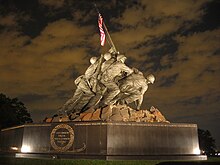Harlon Block
Harlon Henry Block (November 6, 1924 – March 1, 1945) was a United States Marine Corps corporal who was killed in action during the Battle of Iwo Jima in World War II.Born in Yorktown, Texas, Block joined the Marine Corps with seven high school classmates in February 1943.The first flag raised over Mount Suribachi at the south end of Iwo Jima was deemed too small.[1] Block was not recognized as one of the second flag-raisers until the Marine Corps announced in January 1947 (after an investigation) that he was in the photograph and Sergeant Henry Hansen was not.[7] Edward Frederick Block was a World War I veteran and supported his family by working as a dairy farmer.Harlon Block was expelled in his freshman year when he refused to tell the principal which student had vandalized the school.Block then transferred to Weslaco High School and was remembered as an outgoing student with many friends.A natural athlete, Block led the Weslaco Panther Football Team to the Conference Championship.[9][10] Divisions Block and seven of his high school football teammates[11] enlisted in the Marine Corps on February 18, 1943, through the Selective Service System at San Antonio.On December 22, he was assigned to Headquarters Company, 3rd Parachute Battalion, I Marine Amphibious Corps.On the morning of February 23, Lieutenant Colonel Chandler W. Johnson, commander of the Second Battalion, 28th Marines, ordered E Company's executive officer, First Lieutenant Harold Schrier, to take a platoon-size patrol up 556-foot-high Mount Suribachi to seize and occupy the crest, and if possible, raise the battalion's flag to signal the summit was secure.Captain Dave Severance, E Company's commander, assembled a 40-man patrol for the mission from the remainder of his Third Platoon and other members from the battalion.The flagstaff was then taken to the highest position on top and raised by Lt. Schrier, Platoon Sergeant Ernest Thomas, Sergeant Henry Hansen,[13] and Corporal Charles Lindberg at about 10:30 a.m.[14] Seeing the raising of the national colors immediately caused loud cheers from the Marines, sailors, and Coast Guardsmen on the south end beaches of Iwo Jima and from the men on the ships near the beach.Hansen, Private Phil Ward, and Navy corpsman John Bradley pitched in to help make the flagstaff stay in a vertical position.On March 26, 1945, the island was considered secure and the battle of Iwo Jima was officially ended.Block was mortally wounded by an enemy mortar round explosion while leading the squad during an attack toward Nishi Ridge.Block was originally buried in the 5th Marine Division Cemetery on Iwo Jima on March 5, 1945.In 1995, his body was moved to a burial place at the Marine Military Academy near its Iwo Jima monument in Harlingen, Texas.[25] Sculptor Felix de Weldon was inspired to make the memorial after seeing Rosenthal's photograph of the second flag raising.Moreau, U.S. Marine Corps (Retired), President, Marine Corps War Memorial Foundation; General Shepherd, who presented the memorial to the American people; Felix de Weldon, sculptor; and Richard Nixon, who gave the dedication address.[26] Inscribed on the memorial are the following words: On March 20, 1945, President Roosevelt ordered the flag-raisers in Rosenthal's photograph to Washington D.C. after the battle.He was questioned the same day by a Marine public information officer about all the identities of the flag raisers in the photograph.Hayes that the identities were made public on April 8 and would not be changed, and to not say anything about it anymore (the officer later denied that Pfc.[29][4] A Marine Corps investigation of the identities of the six second flag-raisers began in December 1946 and concluded in January 1947 that it was Cpl.[30][31] A third Marine Corps investigation into the identities of the six second flag-raisers concluded in October 2019, that Harold Keller was in the Rosenthal's photograph in place of Rene Gagnon (fifth from left).




#1, Cpl. Harlon Block (KIA)
#2, Pfc. Harold Keller
#3, Pfc. Franklin Sousley (KIA)
#4, Sgt. Michael Strank (KIA)
#5, Pfc. Harold Schultz
#6, Pfc. Ira Hayes
Yorktown, TexasIwo JimaVolcano IslandsWeslaco, TexasMarine Military AcademyHarlingen, TexasUnited States Marine Corps2nd Battalion, 28th Marines5th Marine DivisionWorld War IIBougainville CampaignConsolidation of the Northern SolomonsBattle of Iwo JimaPurple Heart MedalCombat Action RibbonParamarineBougainvilleU.S. flagMount SuribachiRaising the Flag on Iwo JimaJoe RosenthalriflemanwirephotoHenry HansenMarine Corps War MemorialArlington, VirginiaSeventh day-AdventistWorld War IRio Grande ValleyWeslaco High SchoolSeventh-dayAdventist ChurchHistoryChristianityProtestantismMillerismGreat Disappointment1888 General ConferenceTheology28 Fundamental BeliefsPillarsThree Angels' MessagesSabbathEschatologyPre-Second Advent JudgmentPremillennialismConditional immortalityRemnantOrganizationGeneral ConferenceEast-Central Africa DivisionEuro-Asia DivisionInter-American DivisionInter-European DivisionNorth American DivisionNorthern Asia-Pacific DivisionSouthern Africa-Indian Ocean DivisionSouth American DivisionSouth Pacific DivisionSouthern Asia DivisionSouthern Asia-Pacific DivisionTrans-European DivisionWest-Central Africa DivisionPeriodicalsAdventist ReviewSigns of the TimesList of Ellen White writingsAdventist Development and Relief AgencyMaranatha Volunteers InternationalPathfindersAdventurersMedical Cadet CorpsSeventh-day Adventist educationSecondary schoolsColleges and universitiesHospitalsMedia ministriesHope ChannelLoma Linda Broadcasting NetworkIt Is WrittenVoice of ProphecyThree Angels Broadcasting NetworkAmazing FactsPeopleEllen G. WhiteJames S. WhiteJoseph BatesJ. N. AndrewsUriah SmithJ. H. KelloggJames Caleb JacksonW. C. WhiteF. D. NicholM. L. AndreasenLe Roy FroomArthur L. WhiteGeorge VandemanH. M. S. RichardsEdward HeppenstallHerbert E. DouglassMorris VendenSamuele BacchiocchiE. E. ClevelandWalter VeithMark FinleyAdventismSelective Service SystemSan AntonioMarine Corps Recruit DepotSan Diegoparachuteprivate first classPacific TheaterNew Caledonia1st Marine Parachute RegimentI Marine Amphibious Corps2nd Battalion, 28th Marine RegimentCamp Pendleton, CaliforniaHawaiicorporalUSS TalladegaUSS Missoula28th MarinesChandler W. JohnsonHarold SchrierDave SeveranceErnest Thomas
